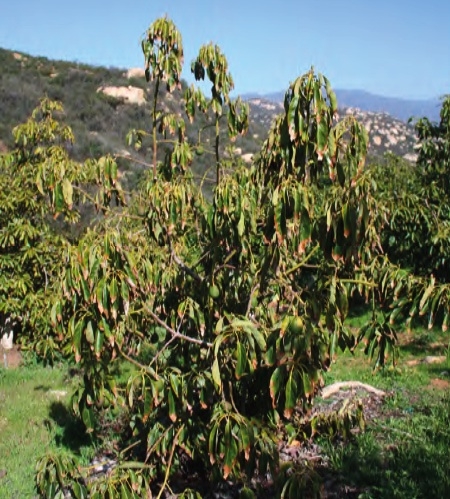Root rot
Root rot is a term referring to any disease where the pathogen damage and deteriorate the plant’s root system. Root rot can occur on most woody and herbaceous plants. Root rot is caused by many soil-borne fungi. Most fungi causing root rot to prefer wet soil conditions. Some of them produce spores (microscopic biological particles that allow fungi to be reproduced) that can survive for a long time in soil or plants debris.
Symptoms
- Small, pale green, or yellow leaves
- Wilted leaves
- Leaves show necrotic or brown tips
- Spare foliage and rare new growth
- Branch dieback on top of the tree
- A decline in fruit production
- Small fruits

Cause
- Excess soil moisture or poor drainage
- Infested soil with fungi spores
Management
Before infection
- Monitor your tree regularly for disease and disease-promoting conditions
- Purchase certified disease-free trees
- Purchase root rot resistant cultivars
- Inspect new tree before planting (roots and foliage)
- Good irrigation management (stop irrigation when heavy rainfall)
- Avoid planting your tree where you suspect there was an infected tree before
- Plant in well-drained soil (or improve drainage by planting on a soil berm)
- Prevent soil or water movement from an infested area
- Apply gypsum (gypsum supplies calcium which suppresses the formation of spores
- Use fertilizer regularly to promote good growth
After Infection
- Reduce irrigation schedule (especially when you forecast rainfall)
- Add drainage around the tree
- Dry root system by removing soil from the crown of the root system (Air drying)
- Reapply gypsum
- Apply fungicides such as phosphonates can help trees tolerate the disease. To apply the fungicide, follow the label. Fungicide may be sprayed onto bark or foliage, drench into the soil with irrigation water, or injected into the trunk. Remember fungicide can only help control the disease, not eradicate it.
Reference:
UC IPM Pest Management Guidelines: Avocado
https://www2.ipm.ucanr.edu/agriculture/avocado/Phytophthora-root-rot/
 0
0
